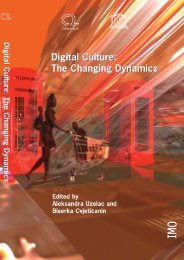free download in pdf format - Culturelink Network
free download in pdf format - Culturelink Network
free download in pdf format - Culturelink Network
You also want an ePaper? Increase the reach of your titles
YUMPU automatically turns print PDFs into web optimized ePapers that Google loves.
How social media enforce glocalization - the processes of identity change <strong>in</strong> selected ...<br />
new then about new social media? Th ey are mostly <strong>free</strong> of charge, easy to use and access,<br />
web based, spread across unprecedented numbers of global populations and technically<br />
more developed s<strong>in</strong>ce they enable the manipulation of text, images and videos. Th ey<br />
are currently dom<strong>in</strong>at<strong>in</strong>g the usage of World Wide Web <strong>in</strong> almost all countries around<br />
the world.<br />
S<strong>in</strong>ce these processes <strong>in</strong>volv<strong>in</strong>g Web 2.0 social media are new and still not part of<br />
substantial social and cultural research we will attempt to describe the ma<strong>in</strong> processes<br />
and mechanisms that can and do <strong>in</strong>fl uence the reshuffl <strong>in</strong>g of cultural identities3 <strong>in</strong> a<br />
process of glocalization <strong>in</strong> Central and Southeast European countries. We understand<br />
glocalization as the ma<strong>in</strong> process of cultural change <strong>in</strong> the process of globalization.<br />
Robertson defi nes it not as a polarity but as a complex relationship between the global<br />
and the local (1995: 35). 4<br />
Th e argumentation <strong>in</strong> the article is mostly theoretical and conceptual. Th e fi rst<br />
section deals with globalization <strong>in</strong> general and the spread of communication structures<br />
<strong>in</strong> particular which <strong>in</strong>fl uence the processes of shap<strong>in</strong>g and reshap<strong>in</strong>g cultures. In the<br />
next section we describe how media communication types <strong>in</strong> contemporary network<br />
societies are be<strong>in</strong>g fundamentally changed. In the ensu<strong>in</strong>g section we discuss how the<br />
notions of media space have evolved from hyperreality to virtual reality to digital<br />
space. In the follow<strong>in</strong>g section we describe how Facebook as a technological context<br />
enables communication and cultural identity reshap<strong>in</strong>g. F<strong>in</strong>ally we discuss the ways of<br />
reshuffl <strong>in</strong>g national culture through the example of Wikipedia.<br />
Rid<strong>in</strong>g the globalization tide<br />
Th e ma<strong>in</strong> characteristics of globalization are far-reach<strong>in</strong>g changes of nation states and<br />
national societies. Beck describes globalization as a process <strong>in</strong> which transnational actors<br />
<strong>in</strong>creas<strong>in</strong>gly <strong>in</strong>terconnect and <strong>in</strong>fl uence the reduction of power of nation states and underm<strong>in</strong>e<br />
their <strong>in</strong>fl uence. Globalization produces diff erent, more or less autonomous logics: economic,<br />
cultural, ecological, political, and so forth (Beck, 2003: 28). However, the ma<strong>in</strong> characteristic<br />
of all these processes is that they change the spatial and temporal coord<strong>in</strong>ates of social relations.<br />
Giddens describes globalization through a “disembedd<strong>in</strong>g mechanism” of lift <strong>in</strong>g out the social<br />
relations from their local <strong>in</strong>teraction contexts and their restructur<strong>in</strong>g <strong>in</strong>side an unspecifi ed<br />
time-space expansion (1990: 21). What Giddens means by space is, however, rather vague.<br />
Is it transborder space of <strong>in</strong>terconnected national territories or is it perhaps media space <strong>in</strong><br />
a media broadcast<strong>in</strong>g or network paradigm? What <strong>in</strong>fl uences most the disembedd<strong>in</strong>g of<br />
3 We understand cultural identity as be<strong>in</strong>g formed and reshaped through processes of discursive<br />
exchange of values and symbols <strong>in</strong> the process of <strong>in</strong>teraction and communication.<br />
4 “Th e global is not <strong>in</strong> and of itself counterposed to the local. Rather, what is oft en referred<br />
to as the local is essentially <strong>in</strong>cluded with<strong>in</strong> the global. In this respect globalization, defi ned<br />
<strong>in</strong> its most general sense as the compression of the world as a whole, <strong>in</strong>volves the l<strong>in</strong>k<strong>in</strong>g of<br />
localities” (Robertson, 1995: 35).<br />
87



